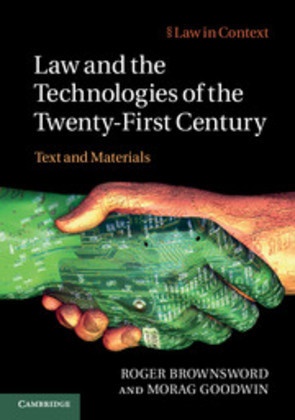Read more
Informationen zum Autor Roger Brownsword is Professor of Law at King's College London. He has been teaching in university law schools since 1968 and currently teaches 'Law and the Technologies of the Twenty-First Century' to students at both King's College London and Singapore Management University. He is a co-founding editor of the journal Law, Innovation and Technology and a member of the editorial board of the Modern Law Review. He has published extensively in the fields of contracts and the common law, legal theory, bioethics and the regulation of technology. Morag Goodwin is a senior lecturer at Tilburg University. She has worked as a field researcher at the European Roma Rights Center, Budapest and as an Assistant Professor at the Faculty of Law, Maastricht University. She is a founding member of the editorial board of the German Law Journal and is a member of the editorial committee of the Netherlands Journal of Legal Philosophy. Klappentext A clear and comprehensive introduction for students studying key regulatory challenges posed by technologies in the twenty-first century. Zusammenfassung A clear and comprehensive introduction for students studying key regulatory challenges posed by technologies in the twenty-first century. Co-authored by a leading scholar in the field with a new scholar to the area! it combines comprehensive knowledge with a fresh perspective. Essential reading for students of law and technology. Inhaltsverzeichnis Part I. General Introduction: 1. Law and the technologies of the twenty-first century; 2. The regulatory environment: UK Biobank, eBay, and Wikipedia; 3. Four key regulatory challenges; 4. Technology as a regulatory tool: DNA profiling and Marper; Part II. Regulatory Prudence and Precaution: 5. Regulatory prudence I: health, safety and environment, GM crops, nanoparticles, and sound science; 6. Regulatory prudence II: precaution; Part III. Regulatory Legitimacy: 7. The legitimacy of the regulatory environment - the basic ideas; 8. Key boundary-marking concepts; 9. Human rights as boundary-markers; 10. Understanding procedural legitimacy - the role of public participation in technology regulation; Part IV. Regulatory Effectiveness: 11. Regulatory effectiveness I; 12. Regulatory effectiveness II: failure by regulators; 13. Regulatory effectiveness III: resistance by regulatees; 14. Regulatory effectiveness IV: third-party interference and disruptive externalities; Part V. Regulatory Connection: 15. Regulatory connection I: getting connected; 16. Regulatory connection II: disconnection and sustainability; Part VI. Concluding Overview: 17. From law to code: the surveillance society and Marper revisited....

